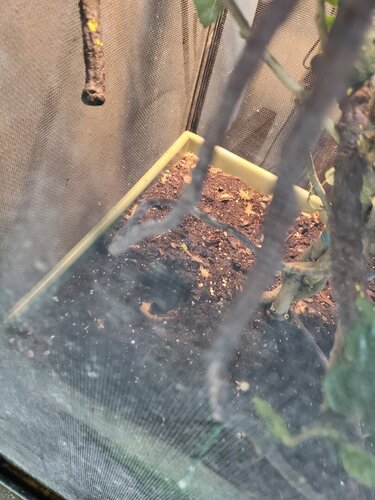Sheriff Brendo
New Member
My female veiled chameleon, Carmela, has recently stopped eating. I first noticed this a couple days ago and she’s still refusing to eat. I’m aware chameleons will sometimes go on hunger strikes but she has a pretty varied diet (mainly crickets & mealworms, with an occasional super, and a hornworm once in a blue moon as a treat). She also enjoys munching down on lettuce and the occasional nibble out of the plants in her enclosure. With that being said I’d say it’s been coming up on about a week of her so called “hunger strike” and I’m beginning to worry. I’ve managed to get her to catch a mealworm or two over the past few days but that’s about it, as she was ignoring some leftover crickets hanging out under the lights in her cage for a few days. I’d appreciate any help or input given to me as I’m concerned for her health and well-being and am beginning to consider a trip to the vet but would like to avoid this if possible.
I’ll provide as much information about her and her enclosure as I possibly can. I appreciate any help you all can give. Have a Happy New Year!
Carmela:
-Veiled Chameleon (Female)
-Purchased 2-3 months ago, I’d guess her age is around 4-5 months
-Unsure about her weight, but I’ll attach pictures I took of her today down below
-Mainly eats crickets, mealworms, occasional super, and hornworms as treats, along with vegetables mainly lettuce.
Carmela’s Enclosure:
-Location: My bedroom, low traffic w/ no loud noises
-Ambient Temp: 75 during day
-Basking Temp: 88+
-Humidity: 40-50%
-Misting: Multiple times a day, 2-3 at least, there’s also a dripper for her
-Handling: Often, she’s very social and likes to come out & explore/crawl all over me and others and explore my room
-Plants: Two pothos plants, a money tree, a bromeliad, two dracaena plants, anthurium (flamingo flower), a fake plastic plant that came with the reptibreeze enclosure, and an elephant ear plant
-Substrate: I know I’ll get chastised for this and trust me I’ve read all about how chams shouldn’t have any substrate but I digress...
I have two plastic bins in the bottom of her cage filled with soil I bought from my local pet store specifically made for “tropical environment” animals. It’s very fine and it’s mostly made of peat moss which I’ve read shouldn’t cause any issues. I potted my plants in these bins so it’s easier to clean, water them, perform maintenance, and so that they double as an egg laying bin.
I’ll provide as much information about her and her enclosure as I possibly can. I appreciate any help you all can give. Have a Happy New Year!
Carmela:
-Veiled Chameleon (Female)
-Purchased 2-3 months ago, I’d guess her age is around 4-5 months
-Unsure about her weight, but I’ll attach pictures I took of her today down below
-Mainly eats crickets, mealworms, occasional super, and hornworms as treats, along with vegetables mainly lettuce.
Carmela’s Enclosure:
-Location: My bedroom, low traffic w/ no loud noises
-Ambient Temp: 75 during day
-Basking Temp: 88+
-Humidity: 40-50%
-Misting: Multiple times a day, 2-3 at least, there’s also a dripper for her
-Handling: Often, she’s very social and likes to come out & explore/crawl all over me and others and explore my room
-Plants: Two pothos plants, a money tree, a bromeliad, two dracaena plants, anthurium (flamingo flower), a fake plastic plant that came with the reptibreeze enclosure, and an elephant ear plant
-Substrate: I know I’ll get chastised for this and trust me I’ve read all about how chams shouldn’t have any substrate but I digress...
I have two plastic bins in the bottom of her cage filled with soil I bought from my local pet store specifically made for “tropical environment” animals. It’s very fine and it’s mostly made of peat moss which I’ve read shouldn’t cause any issues. I potted my plants in these bins so it’s easier to clean, water them, perform maintenance, and so that they double as an egg laying bin.
Attachments
-
 8BF26DB0-A357-4D55-AC15-2551ECBB3FA1.jpeg100.5 KB · Views: 156
8BF26DB0-A357-4D55-AC15-2551ECBB3FA1.jpeg100.5 KB · Views: 156 -
 351259B8-F749-43BD-9C5E-33C166BAE8F7.jpeg60.6 KB · Views: 143
351259B8-F749-43BD-9C5E-33C166BAE8F7.jpeg60.6 KB · Views: 143 -
 F54F0379-D19D-4A8E-9977-45D6FBF36173.jpeg52 KB · Views: 134
F54F0379-D19D-4A8E-9977-45D6FBF36173.jpeg52 KB · Views: 134 -
 C0471677-4AFD-42F5-A288-20EE3F0A4709.jpeg55.2 KB · Views: 148
C0471677-4AFD-42F5-A288-20EE3F0A4709.jpeg55.2 KB · Views: 148 -
 855592CA-34A8-42E0-8A75-535614273E76.jpeg191.4 KB · Views: 157
855592CA-34A8-42E0-8A75-535614273E76.jpeg191.4 KB · Views: 157 -
 3D5F457B-9C4A-47BD-95D2-FC9E36E116BE.jpeg211.3 KB · Views: 153
3D5F457B-9C4A-47BD-95D2-FC9E36E116BE.jpeg211.3 KB · Views: 153 -
 750EFD72-6D0E-468E-A6FF-939B2254829B.jpeg204.5 KB · Views: 161
750EFD72-6D0E-468E-A6FF-939B2254829B.jpeg204.5 KB · Views: 161





